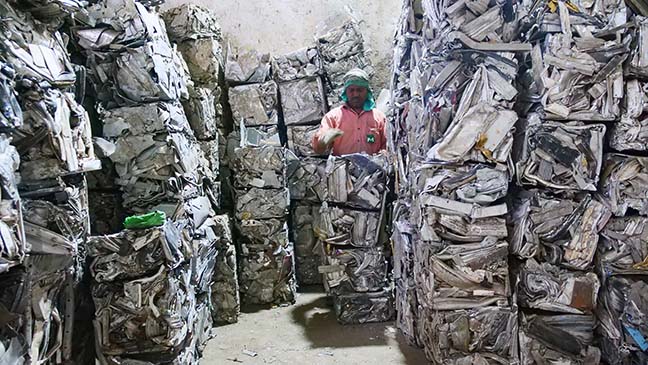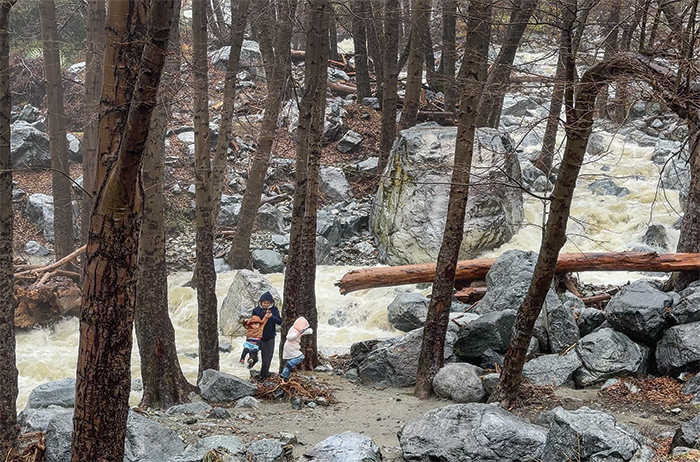‘Scrap’ documentary a love letter to objects at the ‘end of life’

In this still from the film “Scrap,” a worker processes electronic waste in Delhi, India. The film screens at the Laemmle Claremont 5 at 7:30 p.m. Monday November 28, and 1 p.m. Tuesday, November 29. Photo/Anuj Singh
by Steven Felschundneff | steven@claremont-courier.com
Some 30 years ago, El Roble science teacher Joan Felsch, who was also this reporter’s mother, was fond of asking her seventh and eight grade students: “When you throw something away, where is away?”
The question was intended to spark a discussion about waste, and to get her students thinking about what happens to the physical stuff we no longer need. Now a film called “Scrap,” screening this week at the Laemmle Claremont 5, explores that very topic on a more metaphysical and much larger scale.
Through the documentary, viewers are invited to “Discover the vast and strangely beautiful places where things go to die and meet the people who collect, restore, and recycle the world’s scrap.” Residents of California have become accustomed to the “reduce, recycle, reuse” mantra, which has been part of our daily lives for more than 30 years. This film focuses on waste in the largest scale, objects like cars, planes and ships, which have reached the end of their usefulness.

The documentary film “Scrap,” which examines the beauty and tragedy of things we throw away, screens at the Laemmle Claremont 5 at 7:30 p.m. Monday November 28, and 1 p.m. Tuesday, November 29.
Written and directed by Stacey Tenenbaum, “Scrap” premiered at the 2022 Hot Docs film festival last spring in Toronto. The film screens at the Laemmle Claremont 5 at 7:30 p.m. Monday November 28, and 1 p.m. Tuesday, November 29.
“I am fascinated by things that carry their history and am nostalgic for a time when life was slower, and things were built to last,” Tenebaum said through the film’s website. “It was this nostalgia that I wanted to capture in SCRAP. I made the film to show the beauty of objects that have reached their ‘end of life’ and to get people thinking about what happens to things like planes, ships, and phonebooths when they have outlived their use.”
The filmmaker’s motivation is two pronged: the love of old mechanical objects and a desire to illustrate the detritus of a world obsessed with consumption.
“SCRAP is a love letter to the things we use in our daily lives,” reads the film’s synopsis. “This cinematic documentary tells the stories of people who each have a connection to objects that have reached their ‘end of life’. Together their stories convey a deeper environmental and human message about our relationship to things, the sadness we feel at their eventual loss, and the joy we can find in giving them a new purpose. The film raises awareness about the fate of the things we use and explores how artists, and other creative thinkers, can be a part of giving new life to the things we discard.”
Tenebaum lets the people in her film tell their stories, which are mixed with luxurious visuals from director of photography, Katerine Giguére, and an original soundtrack composed by Ramachandra Borcar. The use of slow motion aerials enhances the lonely beauty of the discarded objects.
The movie opens with one of those slow aerials as we glide through Old Car City, a 35-acre scrap yard in White, Georgia owned by Dean Lewis. The camera follows Lewis as he ambles about his land with 4,400 vintage automobiles, most of which are slowly returning to the earth.
“Art is the way the vegetation, the trees have grown up through and around the cars … that’s art,” Davis said. “They’re going back to the earth … most of them’s going back.”
The aerials become particularly evocative as the objects become larger, like the family in Bangkok, Thailand who live in the fuselage of an old passenger airliner, or a facility in Gijon, Spain that dismantles enormous cargo ships. Another of the story’s protagonists, Tchely Hyung-Chul Shin, repurposes portions of these ships into sculptures, including Temp’L, an art installation created from a discarded ocean liner.
“Governments and corporations must dispose of tons and tons of materials each year — a recycling and disposal challenge which can have global implications,” Tenebaum said. “The two main drivers of our waste problem are overconsumption and disposable culture. Things are made cheaply to be used and thrown away. Obsolescence is built into products and consumers are encouraged to upgrade rather than fix.”
As society becomes more and more computerized, fewer objects can be repaired and even fewer people know how to repair them. And people who still have the skills are often stymied by manufacturers that actively discourage repairing machines so they can sell consumers more stuff. Recently, the “right to repair’ movement is aiming to reverse this trend by requiring companies to make products that can be fixed and provide consumers with the technical information needed to perform the repair.
“People are aware of the need to recycle, but recycling is a band-aid solution which does nothing to address the root causes of this problem,” Tenebaum said. “By showing the fate of these objects, I hope to open a discussion about how we can change our production and consumption habits to extend the lifecycle of the things we use.”
The film is filled with other inspirational figures like Tony Inglis, who restores British phone booths, sculptor John Lopez, and Ed Metka, who is a lifetime street car enthusiast.
“Scrap” will screen at the Laemmle Claremont 5 at 7:30 p.m. Monday November 28, and 1 p.m. Tuesday, November 29. More info is at laemmle.com/theater/claremont-5.








0 Comments